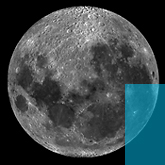 |
CHAMÄLEON + ONJALA OBSERVATORY – LUNAR
ATLAS Segment 12 |
back to OVERVIEW HOME CHAMÄLEON |
|

|
|||
| Moonage 11.5/11.6 days (83-84
%) Kepler Aristarch plateau |
Moon age 12.1/12.6 days (87-92
%) Kepler Domefield Marius Hills NEW 2016 Wollaston Dome Aristarchus plateau (Herodotus + Wollaston domes), Vallis Schröter Mons Rümker and Domefield Reiner |
Moon age 13.1 Tage (95 %) Domefield Marius Hills Mons Rümker and Domefield Reiner |
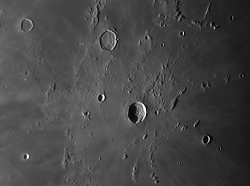 |
Kepler Ke 1
- Moon age 11.5 days (83 %) Kepler 01 is an effusive dome of class C2 with a diameter of nearly 14 kilometers and a height of 170 meters. East of Kepler there seem to be two areas of pyroclastic deposits. The area of Kepler Ke 1 a short time later - at a Moon age of 11.6 Tage (84 %). |
 |
Aristarch plateau
- Moon age 11.6 days (84 %) The Aristarchus plateau (roughly 200 x 200 km) is surrounded by the lava of Oceanus Procellarum and is one of the most mysterious regions on teh Moon. The image dates from 2013 and shows impressively the rhombic structure of the plateau. The largest sinusoidal rille "Vallis Schröter" is a former lava channel. The structure marked with "Cobra Head" in the picture is probably the former volcanic vent or Caldera. More sinusoidal lava channels are near the crater Prince. The plateau seems to be a gigantic land uplift which has been raised about 2000 meters above the Oceanus Procellarum by a massive intrusion of magma. It is completely covered with a 30 centimeter thick layer of pyroclastic ash. |
The plateau is much older than the surrounding lava of Oceanus Procellarum. That results solely from the crater density between the plateau and the Oceanus Procellarum.
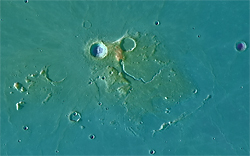 |
LRO height map of the Aristarch
plateaus The image to the left shows a color-coded height map of the Aristarchus plateau from the LRO Wide Angle Camera in equidistant cylindrical projection. Based on the mean height of the Moon, the crater floor of Aristarchus is at a depth of 3000 meters. The surrounding lava of Oceanus Procellarum is about 2 200 m below zero and the plateau is on average +800 meters. The highest peaks, just south of Caldera "Cobra Head", are 1400 meters above the surrounding terrain. Between the plateau and the Montes Agricola there is an area approximately 2300 metersbelow zero. The highest mountains peak above this area with a height |
The sinusoidal rille Vallis Schröter, a former magma channel, in the vicinity of the "Cobra Head" has a width of about 5 km, a depth of about 700 meters and a length of 185 kilometers. Imagine a channel from Hannover to Hamburg with hot lava inside!
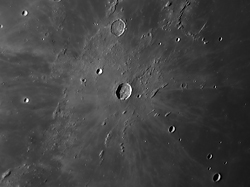 |
Kepler Ke 1
- Moon age 12.1 days (87 %) The image shows Ke 1 at an illumination of 87 %. In the image a putative pyroclastic deposit is marked with Ke A. Kepler Ke 1 not really visible here. The image also shows two Milichius domes Phi and M 6. Milichius 6 is a large dome with a diameter of 20 km and a height of 230 meter. A large caldera with pyroclastic deposit is visible. |
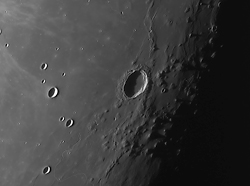 |
Marius Hills
- Moon age 12.1 days (87 %) The dome field west of Marius (41 km) is the largest one on the near side of the Moon. It is located in Oceanus Procellarum and includes about 300 effusive dome-like structures. But their appearance is significantly different from normal domes. The Marius domes have steeper flank angles than normal effusive domes, such as Kies Phi or Herodotus 1 south of the Aristarchus plateau. The structure of the domes is similar to the domes in the pyroclastic area southeast of Copernicus (segment 8 B) or as Liebig 1 (segment 11) and Yangel 1 (segment 5 C). They also show a very roung surface which can be the result of pyroclastic ash deposits. The main domes have a diameter of 6-12 kilometers and their heights vary between 120 to 600 meters. In the region are some sinusoidal rille , such as Rima Marius (very long) and Rima Galileo . |
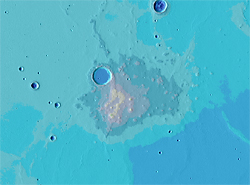 |
LRO height map of Marius Hills The left image shows a color-coded elevation map of the region from the LRO Wide Angle Camera The whole domefield is located on a plateau with a diameter of nearly 200 km and a height of 1200 m above the surrounding lava areas. Maybe it is an intrusive megaplateau. |
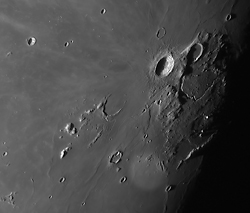 |
NEW 2016 Wollaston Dome
- Moon age 12.3 days (89 %) Two extremely flat lunar domes north of Aristarchus near the small crater Wollaston. The domes are not located on the Aristarchus Plateau but already in the plane of Oceanus Procellarum. In literature there are three domes at this point, cited as Wollaston 1 to 3. But also the LRO image shows just 2 domes, see image below. The domes 1 has a diameter of about 5.5 kilometers at a height of just 45 meters. Dome 2 is with approximately 11 km considerably larger but with a height of only 36 meters nearly one quarter flatter. |
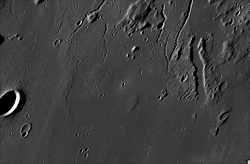 |
NEW 2016 LRO Wollaston
Dome The Wollaston dome with a resolution of 64 m/pxl. |
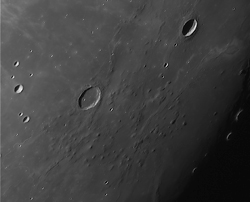 |
Marius Hills
- Moon age 12.5 days (92 %) The Marius Hills, a part of Rima Marius and Rima Galileo at an illumination of 92%. |
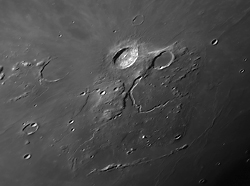 |
Herodutus 1
- Moon age 12.5 days (92 %) South of the Aristarchus plateau tere is a normal effusive dome called Herodotus 1. It is classified as a B1 dome. With a diameter of 14.5 kilometers and a height of 230 meters, it is relatively easy to observe when the illumination conditions are right. Accurate high-resolution LRO images show the two overlapping vents of the caldera. One is of circular shape and the other shows the elongated shape of a peanut in shell with a width of two kilometers. |
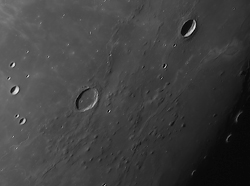 |
Reiner -
Moon age 12.5 days (92 %) In the east and in the west of the crater Reiner (30 km) are 5 small effusive domes R 1 to R 5. It is unclear if these domes are connected to the Marius Hills. Their surface structure appear much smoother than the Marius domes. Their diameters are around 8 kilometers. If you look at the area on the LRO images with a resolution of 125 m/px you can find dozens of other similar structures. |
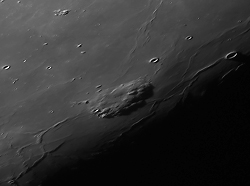 |
Mons Rümker
- Moon age 12.5 (92 %) Mons Rümker is another highlight of the lunar volcanism. It is located in the Sinus Roris on the northwestern edge of the Moon. Mons Rümker is with a diameter of about 65 kilometers the largest contiguous volcanic structure of this Moon atlas. The height varies between 650 and 1 100 meter above the surrounding lava of Oceanus Procellarum. Due to its geometric distortion, caused by the very remote location at the lunar limb, it is difficult to observe. For high-resolution photos a favourable libration is needed. The plateau itself consists of extremely red colored Marelava. On its surface there are 6 separate small effusive domes R1 to R6 with diameters between 5.5 to 9 km and heights between 70 and 240 meters. Mons Rümker is in a line with the Aristarchus Plateau and the Marius Hills. |
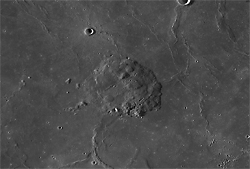 |
LRO Mons Rümker
The left image shows Mons Rümker and the Marius Hills as seen with the LRO Wide Angle Camera in equidistant cylindrical projection with a resolution of 125 m/px. The effusive domes R1 to R5 are marked. |
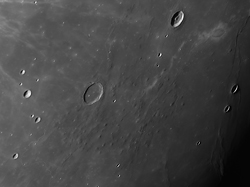 |
Reiner and Marius
Hills - Moon age 13.1 days (95
%) The image shows the 5 effusive domes Reiner 1 to 5 and the area of the Marius Hills with Rima Marius and Rima Galileo. Compared with the above image at an illumination of 87 %, the domes are no longer as vividly visible. |
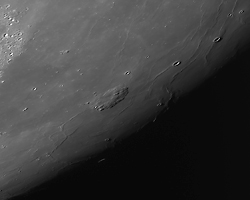 |
Mons Rümker
- Moon age 13.1 days (95 %) Mons Rümker at an illumination of 95 %. The small effusive domes R1 to R4 are clearly visible. |
| top of the page |
 |
 |
 |
 |
 |
 |
 |
 |
 |
 |
 |
 |
| Segm. 01 | Segm. 02 | Segm. 03 | Segm. 04 | Segm. 05 | Segm. 06 | Segm. 07 | Segm. 08 | Segm. 09 | Segm. 10 | Segm. 11 | Segm. 12 |